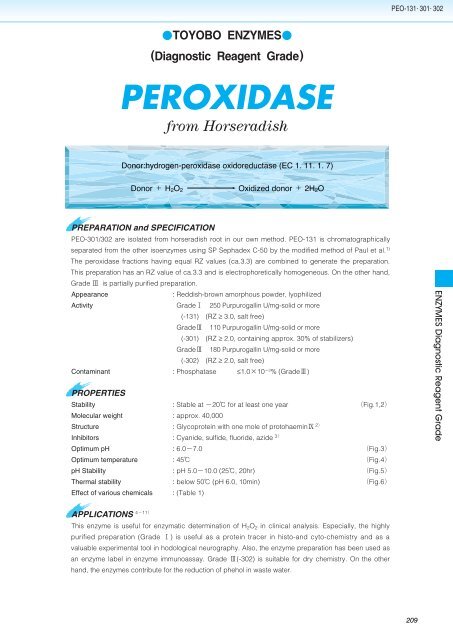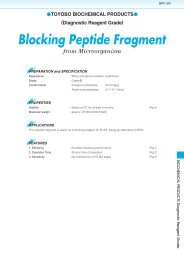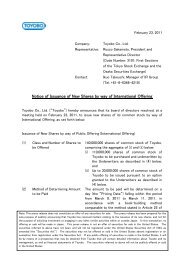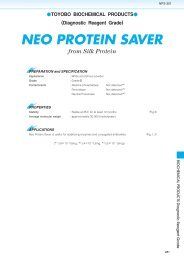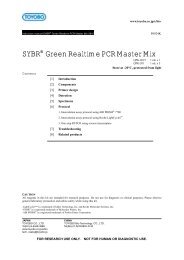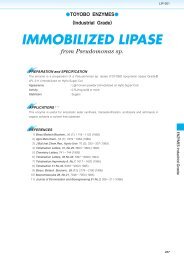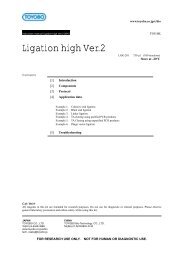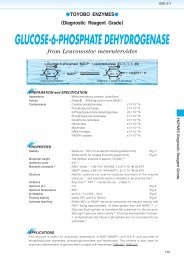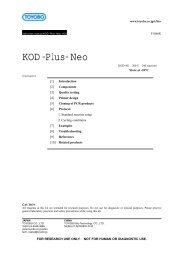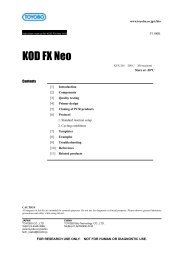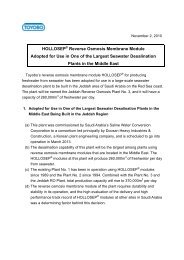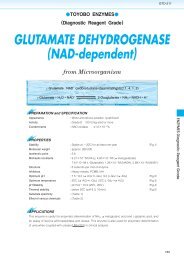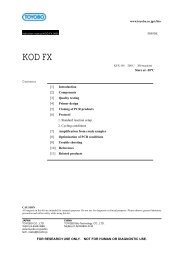PEROXIDASE - Toyobo
PEROXIDASE - Toyobo
PEROXIDASE - Toyobo
Create successful ePaper yourself
Turn your PDF publications into a flip-book with our unique Google optimized e-Paper software.
PEO-131301302TOYOBO ENZYMES(Diagnostic Reagent Grade)<strong>PEROXIDASE</strong>from HorseradishDonor:hydrogen-peroxidase oxidoreductase (EC 1. 11. 1. 7)Donor H 2 O 2Oxidized donor 2H 2 OPREPARATION and SPECIFICATIONPEO-301/302 are isolated from horseradish root in our own method. PEO-131 is chromatographicallyseparated from the other isoenzymes using SP Sephadex C-50 by the modified method of Paul et al. 1)The peroxidase fractions having equal RZ values (ca.3.3) are combined to generate the preparation.This preparation has an RZ value of ca.3.3 and is electrophoretically homogeneous. On the other hand,Grade is partially purified preparation.Appearance: Reddish-brown amorphous powder, lyophilizedActivityGrade250 Purpurogallin U/mg-solid or more(-131) (RZ ≥ 3.0, salt free)Grade110 Purpurogallin U/mg-solid or more(-301) (RZ ≥ 2.0, containing approx. 30% of stabilizers)Grade180 Purpurogallin U/mg-solid or more(-302) (RZ ≥ 2.0, salt free)Contaminant : Phosphatase ≤1.010 3 % (Grade)PROPERTIESStability : Stable at 20 for at least one year Fig.1,2Molecular weight : approx. 40,000Structure: Glycoprotein with one mole of protohaemin 2Inhibitors: Cyanide, sulfide, fluoride, azide 3Optimum pH : 6.07.0 Fig.3Optimum temperature : 45 Fig.4pH Stability : pH 5.010.0 (25, 20hr) Fig.5Thermal stability : below 50 (pH 6.0, 10min) Fig.6Effect of various chemicals : (Table 1)APPLICATIONS 411This enzyme is useful for enzymatic determination of H 2 O 2 in clinical analysis. Especially, the highlypurified preparation (Grade ) is useful as a protein tracer in histo-and cyto-chemistry and as avaluable experimental tool in hodological neurography. Also, the enzyme preparation has been used asan enzyme label in enzyme immunoassay. Grade (-302) is suitable for dry chemistry. On the otherhand, the enzymes contribute for the reduction of phehol in waste water.209
PEO-131301302ASSAYPrinciple:2Pyrogallol3H 2 O 2peroxidasePurpurogallin5H 2 OCO 2The appearance of Purpurogallin is measured at 420nm by spectrophotometry.Unit definition:One purpurogallin unit causes the formation of one milligram of purpurogallin in 20 seconds under the conditionsdescribed below.Method:ReagentsA. Pyrogallol solutionB. H 2 O 2 solutionC. Phosphate buffer, pH6.0D. H 2 SO 4 solution5% (W/V)(Should be prepared fresh).0.147MDilute 1.67ml of 30% (W/V) H 2 O 2 to 100ml with H 2 O(Should beprepared fresh)0.1M2.0NProcedure1. Prepare the following reaction mixture in a test tube (32Concentration in assay mixture200mm) and equilibrate at 20 for about 5 minutes.Phosphate buffer15 mM14.0ml H 2 OPyrogallol40 mM2.0ml Pyrogallol solution (A) H 2 O 27.4mM1.0ml H 2 O 2 solution (B)2.0ml Phosphate buffer, pH6.0 (C)2. Add 1.0ml of the enzyme solutionand mix.3. After exactly 20 seconds at 20, add 1.0ml of 2.0 N H 2 SO 4 solution (D) to stop the reaction.4. Extract the produced purpurogallin from the above stopped reaction mixture in five times with 15ml portionsof ether and fill up the combined ether extracts to 100ml with fresh ether.5. Measure the optical density at 420nm against water (OD test).At the same time, prepare the blank by first mixing the reaction mixture with 1.0ml of 2.0 N H 2 SO 4solution (D) after 20 a sec-incubation at 20, followed by the addition of the enzyme solution and extractingwith ether by the same procedure as the test (OD blank).Dissolve the enzyme preparation in ice-cold 0.1M phosphate buffer, pH 6.0 (C), dilute to 3.06.0 purpurogallin U/ml with the same buffer and store on ice.CalculationActivitycan be calculated by using the following formulaOD(OD testOD blank)dfVolume activity (U/ml) OD8.547df0.117VsWeight activity (U/mg)(U/ml)1/CVs Sample volume (1.0ml)0.117Optical density at 420 nm corresponding to 1mg% of Purpurogallin in ether.df Dilution factorC Enzyme concentration in dissolution (c mg/ml)One purpurogallin unit is equivalent to 13.5 international units determined with o-dianisidine at 25.210REFERENCES1) K.G.Paul and T.Stigbrand; Acta Chem.Scand., 24, 3607 (1970).2) L.M.Shannon et al.; J.Biol.Chem., 241, 2166 (1966).3) E.Kay et al.; J.Biol.Chem., 242, 2470 (1967).4) R.Lasek et al.; Brain Res., 8, 319 (1968).5) W.M.Cowan et al.; Brain Res , 37, 21 (1972).6) J.H.La Vail et al.; Brain Res., 58, 470 (1973).7) A.M.Graybiel and M.Devor; Brain Res., 68, 167 (1974).8) A.H.Bunt et al.; Brain Res., 102, 152 (1976).9) D.R.Colman et al.; Brain Res., 102, 156 (1976).10) M.Dubois-Dalcq et al.; J.Histochem.Cytochem., 25, 1201 (1977).11) M.Sato et al.; Brain Res., 140, 149 (1978).
PEO-131301302Table 1. Effect of Various Chemicals on Peroxidase[The enzyme dissolved in 0.1M phosphate buffer, pH 6.0 (50U/ml) was incubated with each chemical at 25for 1hr.ChemicalConcn.(mM)ResidualactivityChemicalConcn.(mM)ResidualactivityNone 100% MIA 2.0 99Metal salt 2.0NEM 2.0 97MgCl 2 102IAA 2.0 99CaCl 2 102Hydroxylamine 2.0 98Ba(OAc) 2 105EDTA 5.0 95FeCl 3 98o-Phenanthroline 2.0 98CoCl 2 97,-Dipyridyl 1.0 96MnCl 2 97Borate 5098ZnCl 2 99NaF 2.0 98CdCl 2 99NaN 3 2.0 75NiCl 2 96Triton X-100 0.10% 98CuSO 4 98Brij 35 0.10% 80Pb(OAc) 2 96Tween 20 0.10% 89AgNO 3 91Span 20 0.10% 98HgCl 2 92Na-cholate 0.10% 972-Mercaptoethanol 2.0 94SDS 0.05% 98PCMB 1.0 98DAC 0.05% 102Residual activity was measured by 4AA-DEA method4AA, 4-Aminoantipyrine; DEA, DiethylanilineAc,CH 3 CO; PCMB, p-Chloromercuribenzoate; MIA, Monoiodoacetate; NEM, N-Ethylmaleimide; IAA, Iodoacetamide;EDTA, Ethylenediaminetetraacetate; SDS, Sodium dodecyl sulfate; DAC, Dimethyl-benzyl-alkyl-ammonium chloride.100100100Residual Activity,%50-204203040Relative Activity50Residual Activity,%500 2 4 6 8 10 12Period (months)Fig.1. Stability (Powder form)kept under dry conditions04 5 6 7 8pHFig.3. pH-Activity20, 20sec-reaction in 0.1Mbuffer solution: pH4.0-6.0, acetate;pH6.0-8.0, phosphate0 4 6 8 10 12pHFig.5. pH-Stability25, 20hr-treatment with 50mMbuffer solution: pH3.5-6.0, acetate;pH6.0-8.0, phosphate; pH9.0-11.0borate100100100Residual Activity,%50475567Relative Activity50Residual Activity,%500 2 4 6 8Period (days)Fig.2. Stability (Powder form)kept under dry conditions020 40 60Temperature, Fig.4. Temperature activity20sec-reaction in 0.1M phosphatebuffer, pH6.0020 40 60 80Temperature, Fig.6. Thermal stability10min-treatment with 50mMphosphate buffer, pH6.0211
PEO-131301302peroxidase 2 2 2 2 2 2 2 2 PP 2 4 PP P P 2 2 P P 2 4 PPP 2 4 PPPP P P 212


